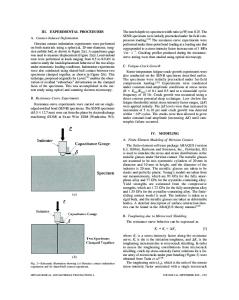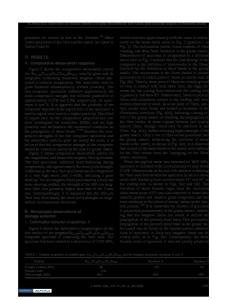Deformation and Fracture Behavior of Metallic Glassy Alloys and Glassy-Crystal Composites
- PDF / 634,299 Bytes
- 7 Pages / 593.972 x 792 pts Page_size
- 50 Downloads / 359 Views
INTRODUCTION
BULK glassy alloys (also called bulk metallic glasses) attract significant attention from materials scientists owing to their promising physical and functional properties.[1–3] Among them, Zr-based glassy alloys have a high glass forming ability compared to other transmission metals (TM)–based alloys, except for some noble metals (NM)–based alloys. The Zr–late transition metal (LTM)-Al and Zr-LTM-NM-Al glassy alloys may have critical diameters up to 30 mm and critical cooling rates below 10 K/s,[1–3] while Zr-LTM-Ti-Be alloys exhibit even lower critical cooling rate of about 1 K/s.[2] A vast majority of bulk glassy alloys breaks shortly after yielding at ambient temperature. However, the deformation behavior of bulk glassy alloys is under intense investigation at present owing to its high strength accompanied with a considerable apparent ductility discovered for several specific alloy compositions. D.V. LOUZGUINE-LUZGIN, Professor, and A. INOUE, President of the University, are with WPI Advanced Institute for Materials Research, Tohoku University, Sendai 980-8577, Japan. Contact e-mail: [email protected] S. LI, Research Associate, A. KAWASHIMA, Assistant Professor, and G. XIE, Associate Professor, are with the Institute for Materials Research, Tohoku University, Sendai, Japan. A. VINOGRADOV, Associate Professor, is with the Department of Intelligent Materials Engineering, Faculty of Engineering, Osaka City University, Osaka 558-8585, Japan. A.R. YAVARI, Professor, is with Institut National Polytechnique de Grenoble, 38402 St-Martin-d’He`res Campus, France. Manuscript submitted April 28, 2010. Article published online August 17, 2010 1504—VOLUME 42A, JUNE 2011
The inhomogeneous plastic flow of glassy alloys occurs at relatively low homologous temperature by propagation of shear bands,[4,5] which are 10- to 20-nm thick and make steps on the surface up to several micrometers in height.[6] A strongly localized shear deformation at room temperature[7,8] limits practical application of such materials, since any shear event may trigger a crack nucleation and rapid fracture. Pd40Ni40SixP20–x[9,10] and Zr65Al7.5Ni10Pd17.5[11] alloys exhibit a significant roomtemperature ductility of several percent and high fracture strength in the glassy state. Similar results were obtained for Pt57.5Cu14.7Ni5.3P22.5[12] alloy, though no structural characterization was provided. Low-temperature measurements have also been performed[13,14] and demonstrated the increase in both the maximum compressive stress and plastic strain to failure with decreasing testing temperature. In order to enhance the ductility of metallic glasses, the formation of heterogeneous microstructures in a composite-like manner has recently been found essential and employed in a variety of procedures combining a glassy matrix with second-phase crystalline particles;[15,16] the deformation-induced nanocrystallization[17] is one of the possible ways of illustrating this approach. The straightforward idea is to impede the rapid propagation of shear band
Data Loading...











